.
ARA´TRUM (ἄροτρον), a plough. The antiquity of its use in Greece may be inferred from the fact that its invention is a subject of legend, being variously attributed to Zeus (Diod. 3.63), Dionysus (Arrian, Ind. 7), Triptolemus (Plin. Nat. 7.199), or the Athenian hero Buzyges (Hesych. sub voce Plin. l.c.). The plough appears again in Athenian legend in the story of the ἥρως Ἐχετλαῖος or Ἔχετλος, who fought against the Persians at Marathon.
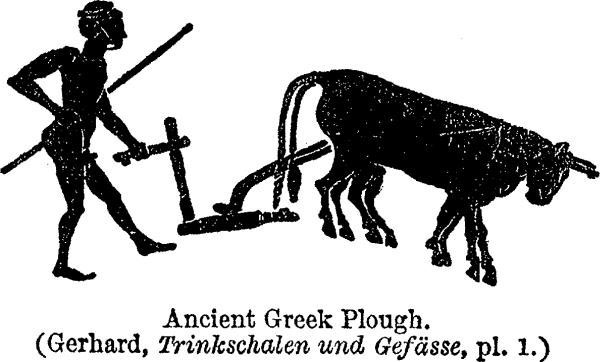
Ancient Greek Plough. (Gerhard,
Trinkschalen und Gefässe,
pl. 1.)
The simplest and earliest form of the plough was that called αὐτόγυον, so called because the γύης or plough-tail and the other parts were of one piece. It was made by taking a young tree with two branches proceeding from its trunk in opposite directions, so that, while the trunk served for the pole, one of the branches stood upwards and became the tail, and the other penetrated the ground, and, being covered sometimes with bronze or iron, fulfilled the purpose of a share. This form is exhibited in fig. 1 of the annexed woodcut, taken from a medal.
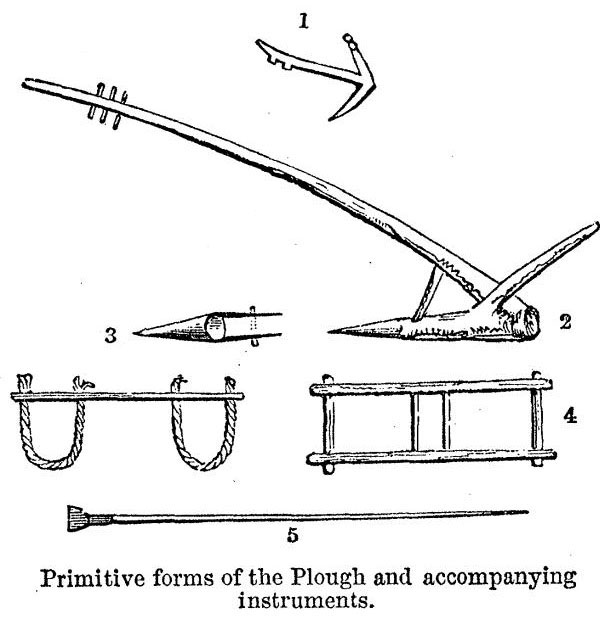
Primitive forms of the Plough and accompanying instruments.
But even in Homer (Hom. Il. 10.353) we hear of the πηκτὸν ἄροτρον, composed of separate pieces of wood; and Hesiod (O. et D. 427-36), who advises the farmer to have a plough of each sort, describes the πηκτὸν ἄροτρον as consisting of the γύης (buris, bura, plough-tail), to be made of a bent piece of ilex; the ῎ελυμα (dentale, share-beam), to be made of oak; and the ἱστοβοεύς (temo, pole), to be made of bay or elm, the parts being joined by nails. Fig. 2 of the above woodcut shows a plough which differs somewhat from Hesiod's in having no distinct γύης, but consisting of ἱστοβοεύς, ἔλυμα and ἐχέτλη (stiva, handle). It is the plough still used in Mysia, according to Sir C. Fellows, who observes (Excurs. in Asia Minor, 1838, p. 71) that each portion of this instrument is still called by its ancient Greek name, and adds that it seems suited only to the light soil where he observed it, that it is held by one hand only, that the form of the share (ὕννις: see fig. 3) varies, and that the plough is frequently used without any share. “It is drawn by two oxen, yoked from the pole, and guided by a long reed or thin stick (κάτρινος), which has a spud or scraper at the end for cleaning the share.” For the yoke see fig. 4; for the κάτρινος, fig. 5.
The plough was no doubt usually drawn by oxen, but mules were esteemed for this work (Hom. Il. 10.351; Od. 8.124).
The later and more developed πηκτὸν ἄροτρον may be regarded as consisting of a share (῞υννις, ὕνις, ὕννη, ὕννης) fitted into a share-beam (ἔλυμα), from which rose the handle (ἐχέτλη), and, curving in the opposite direction, the ῥυμός, the lower and curved part of which was the γύης, the upper the ἱστοβοεύς or pole, across which was fastened the ζυγόν or yoke. The accompanying wooduct, given by Ginzrot from a
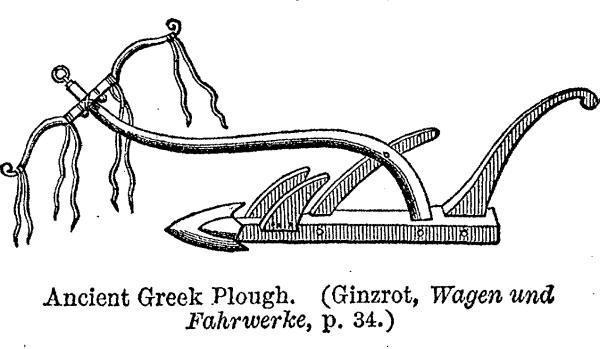
Ancient Greek Plough. (Ginzrot,
Wagen und Fahrwerke,
p. 34.)
bas-relief on the base of a statute of Demeter in Magnesia, shows the γύης strengthened by a piece of wood rising from the ἔλυμα, and also two earth-boards (πτερά, aures) behind the share. The part of the handle which the ploughman grasped was called χειρολαβής; the part where the handle entered the ἔλυμα, ἀλύη; the tip of the share, νύμφη. (Apollon. 3.232, Schol.; Etym. Mag. p. 173; Pollux, 1.252; Hesych.) The arrangements of the yoke are treated of under JUGUM In ancient works of art the parts of the plough are often represented as not nailed together, but lashed with thongs.
The Italian plough, the invention of which the Romans referred to Greek (Verg. G. 1.19) or even Egyptian (Tib. 1.7, 29) legends, had the same simple origin as the Greek (as may be inferred from Etruscan art), and a similar development. Its share was originally of bronze (Macr. Sat. 5.19, 13). Virgil, in a passage (Georg. 1.169-75) probably suggested by Hesiod, recommends that the plough-tail (buris, bura) should be made of elm, bent to the proper shape while growing, the yoke and handle (stiva) of smoke-dried linden or beech. The pole (temo) [p. 1.160]is to be eight feet long, and the plough is furnished with earth-boards or mould--boards (aures), rising on each side and bending outwardly in such a manner as to throw on either hand the soil which had been previously loosened and raised by the share, and adjusted to the share-beam, which was made double for the purpose of receiving them: “Binae aures, duplici aptantur dentalia dorso.” Keightley, however, holds that this is merely a poetical use of the plural, and that the dentale was single. According to Palladius (1.43), it was desirable to have ploughs both with earth-boards (aurita) and without them (simplicia). The handle (stiva), according to Virgil, is used to turn the plough at the end of the furrow: “Stivaque, quae currus a tergo torqueat imos.” Servius, however, in his note on this line, explains stiva to mean “the handle by which the plough is directed.” It is probable that, as the dentalia,--i.e. the two share-beams, which Virgil supposes were in the form of the Greek letter Δ which he describes by duplici dorso,--the buris was fastened to the left share-beam, and the stiva to the right; so that, instead of the simple plough of the Greeks, that described by Virgil, and used no doubt in his country (see the following woodcut), was more like the modern Lancashire plough, which is commonly held behind with both hands. Sometimes, however, the stiva (ἐχέτλη, Hes. Op. et Dies, 467) was used alone and instead of the tail, as in the Mysian plough above represented. To a plough so constructed the language of Columella was especially applicable, “Arator stivae paene rectus innititur” (1.9); and the expressions of Ovid, “Stivaeque innixus arator” (Met. 8.218), and “Inde premens stivam designat moenia sulco” (Fast. 4.825). In place of “stiva,” Ovid also uses the less appropriate term “capulus” (Ep. de Ponto, 1.8, 61): “Ipse manu capulum prensi moderatus aratri.” When the plough was held either by the stiva alone, or by the buris alone, a piece of wood (manicula) was fixed across the summit, and on this the labourer pressed with both hands. Besides guiding the plough in a straight line, his duty was to force the share to a sufficient depth into the soil. Virgil alludes to this in the phrase “Depresso aratro” (Georg. 1.45). The cross-bar, which is seen in Sir C. Fellows's drawing, and which passes from the pole to the share for the purpose of giving additional strength, was called σπάθη, in Latin fulcrum. The coulter (culter, Plin. Nat. 18.171 if.) was used by the Romans as it is with us. It was inserted into the pole so as to depend vertically before the share, cutting through the roots which came in its way, and thus preparing for the more complete loosening and overturning of the soil by the share. The share (comer, vomis) was sometimes lashed under the dentale, sometimes imbedded in it (indutilis: Cato, Cat. Agr. 135, considers this arrangement preferable). Pliny (l.c.) describes the ordinary form of vomer as pointed like a crowbar; another, for use in light lands, did not extend over the whole of the dentale, but formed a slender point to its end; another shape, broader, sharper and sword-like, pierced the ground with its point, and with its edge did the work of a culter.
Pliny also describes (l.c.) a Rhaetian plough called plaustraratrum or plaumoratum (Sillig), furnished with two small wheels (rotae, rotulae), invented not long before his time; and Servius (l.c.) mentions the use of them in the country of Virgil. The annexed woodcut shows the
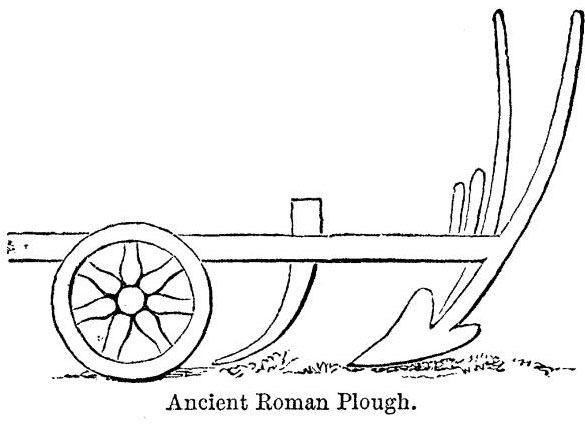
Ancient Roman Plough.
form of a wheel-plough, as represented on a piece of engraved jasper, of Roman workman-ship. It also shows distinctly the temo or pole, the coulter or culter, the dentate or share-beam, the buris or plough-tail, and the handle or stiva (Caylus, Rec. d'Ant. v. pl. 83, No. 6). It corresponds, in all essential particulars, with the plough now used about Mantua and Venice, of which an engraving is given below.
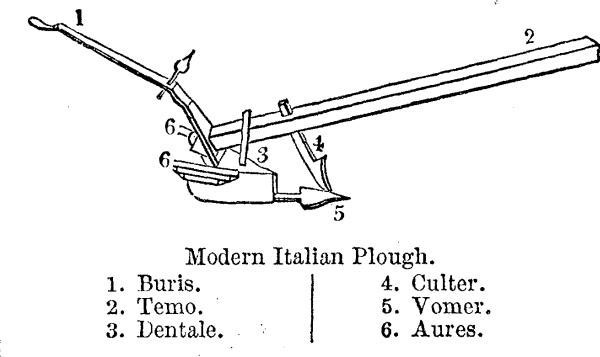
Modern Italian Plough.
1. Buris.
2. Temo.
3. Dentale.
4. Culter.
5. Vomer.
6. Aures.
In Varro (L. L. 5.135) and Columella (R. R. 2.4), the word dens includes vomer and the later dentale, which were originally not distinct parts of the plough. Urvum is used by Servius (ad Verg. l.c.) in the sense generally given to buris, which term he applies to the upper part of the pole, while Festus explains urvum as forma simillima uncini, curvatione buris et dentis, cui praefigitur vomer.
The operations of ploughing are described under AGRICULTURA p. 60b.
[J.Y] [J.H.F]
Dictionary of Greek and Roman Antiquities
| Ancient Greece
Science, Technology , Medicine , Warfare, , Biographies , Life , Cities/Places/Maps , Arts , Literature , Philosophy ,Olympics, Mythology , History , Images Medieval Greece / Byzantine Empire Science, Technology, Arts, , Warfare , Literature, Biographies, Icons, History Modern Greece Cities, Islands, Regions, Fauna/Flora ,Biographies , History , Warfare, Science/Technology, Literature, Music , Arts , Film/Actors , Sport , Fashion --- |


